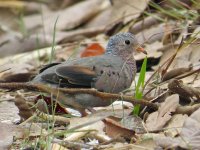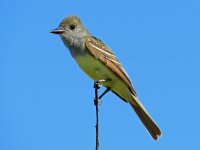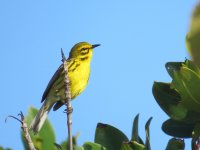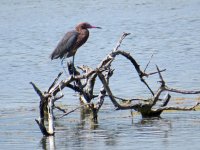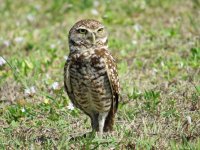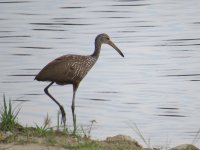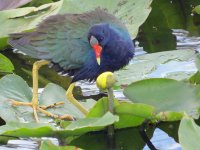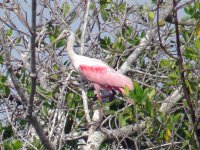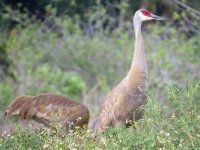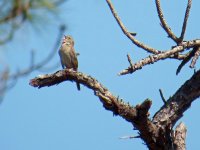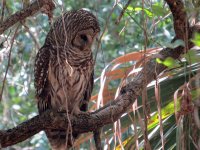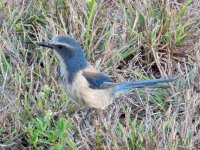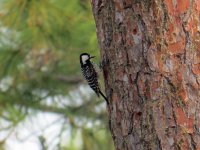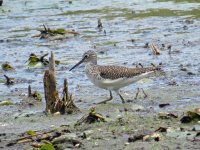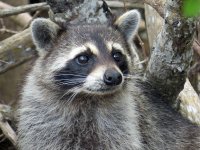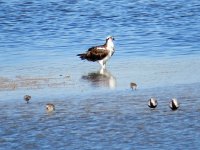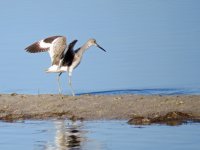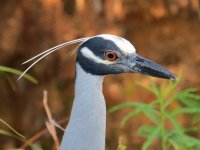sbradfield
Well-known member
Following a very successful trip to Ohio last year we (myself, Simon Hitchen and Dave Rose) were keen to revisit the US. This year we headed for Florida to try to get the Floridian specialities. We had no real interest in the Miami plastics so went for the Keys, Everglades and dry prairie specialities. Mainly by using ebird we lined up likely sites for all our target species. Work and family commitments limited us to 6 nights away.
Logistics:
We flew direct to Miami from Heathrow. Car hire was easily arranged on line and we hired a condo at Big Coppitt Key from HomeAway (just twenty minutes drive from Key West but much cheaper than Key West prices) for two nights. We followed this by a night in Florida City at a Best Western before heading up to Punta Gorda where we stayed at a Knights Inn motel for a couple of nights. There was a lot of driving, easily averaging 4 hour driving a day but with frequent birding stops.
Day One: Thursday 3 May 2018
We arrived in Miami on time and got through immigration very quickly. With a long drive ahead we headed straight for our accommodation on Big Coppitt Key. Traffic out of Miami was stop-start and we only felt we were making progress once we got past Key Largo. We finally arrived at 6.30pm and from our balcony we soon had a fly-by from one of key targets White-crowned Pigeon. With light fading we headed straight to Key West airport in the hope of finding Antillean Nighthawk. We heard a Nighthawk immediately on arrival but it was the “peent” call of a Common Nighthawk. We had good but brief views of this bird (a lifer for two of us) however it was the only Nighthawk to be heard or seen so with darkness having fallen we headed for an excellent dinner at Geiger Key Marina.
Day Two: Friday 4 May 2018
Today we had booked ourselves on a day trip to the Dry Tortugas in the hope of finding migrants and seabirds. The birding commenced at Key West harbour where there were several Least Terns feeding. The first Magnificent Frigatebird of the trip drifted over and a flock of 14 Black Skimmers gave a fly past. A single juvenile American Herring Gull harassed the many Laughing Gulls in the harbour. As the Yankee Freedom III left the harbour we had good views of 3 Royal Terns and the ubiquitous Brown Pelicans.
The boat trip initially produced little in the way of seabirds but we encountered several warblers flying alongside the boat, American Redstarts, Common Yellowthroats, Blackpoll and Palm Warblers. It was a stark reminder of the challenges these tiny birds face to see them out at sea, out of sight of land. Several attempted to land on the boat, which was of course heading in the opposite direction they needed to go. We also had a distant Merlin far out to sea.
As we neared the Tortugas we had our first small flocks of Sooty Terns, followed by a flyby Masked Booby, one of our top targets. The catamaran sails close enough to Hospital Key, (the only nesting site for this species in the USA) to get a good look. The boat even slows down to allow birders on board to take in the sight.
Landing on Garden Key we came across our first migrant, a Northern Waterthrush, feeding on the corpse of a Brown Pelican, nice! It quickly became apparent that there plenty of migrants to see and there had been a decent fall. Most numerous were the American Redstarts, many of which fed around our feet on the beach. As a conservative estimate there must have been 150-200 on Garden Key. In Fort Jefferson Blackpoll, Cape May, Black-and-white, Palm, Parula and Black-throated Blue Warblers were all present in reasonable numbers with ones and twos of Prairie Warblers, Common Yellowthroat, Magnolia Warbler and Ovenbird. Other migrants included Yellow-billed Cuckoo, Grey Kingbird, Bobolink, Indigo Bunting and Grey-cheeked Thrush. Two Merlins were taking advantage of the tired migrants.
As well as migrants the Key is well known for its seabirds. Amongst the many nesting Sooty Terns and Brown Noddies we were able to pick out singles of Tortugas specialities Bridled Tern and Black Noddy as well as a couple of Roseate Terns. A real bonus though was an American Flamingo somewhat out of place on the beach by the Sooty Tern colony. All too soon we had to say farewell to Garden Key for the 2 and a half hour trip back to Key West. The boat trip isn’t cheap at $165 per person but you do get breakfast and lunch included and unlimited water, tea or coffee. Overall we considered it worth the money.
Back on dry land, we had time for a quick tea before heading off to Big Pine Key, where ebird showed several recent records of Antillean Nighthawk. On arrival we soon came across several groups of the endemic and endangered Key West Deer, a diminutive subspecies of White-tailed Deer. As the sky darkened we heard the diagnostic “pitty-pit-pit” (which reminded of the noise of a particularly annoying giggle stick my children used to own) and soon saw a couple hunting over the houses and gardens. A good finish to a great day.
Logistics:
We flew direct to Miami from Heathrow. Car hire was easily arranged on line and we hired a condo at Big Coppitt Key from HomeAway (just twenty minutes drive from Key West but much cheaper than Key West prices) for two nights. We followed this by a night in Florida City at a Best Western before heading up to Punta Gorda where we stayed at a Knights Inn motel for a couple of nights. There was a lot of driving, easily averaging 4 hour driving a day but with frequent birding stops.
Day One: Thursday 3 May 2018
We arrived in Miami on time and got through immigration very quickly. With a long drive ahead we headed straight for our accommodation on Big Coppitt Key. Traffic out of Miami was stop-start and we only felt we were making progress once we got past Key Largo. We finally arrived at 6.30pm and from our balcony we soon had a fly-by from one of key targets White-crowned Pigeon. With light fading we headed straight to Key West airport in the hope of finding Antillean Nighthawk. We heard a Nighthawk immediately on arrival but it was the “peent” call of a Common Nighthawk. We had good but brief views of this bird (a lifer for two of us) however it was the only Nighthawk to be heard or seen so with darkness having fallen we headed for an excellent dinner at Geiger Key Marina.
Day Two: Friday 4 May 2018
Today we had booked ourselves on a day trip to the Dry Tortugas in the hope of finding migrants and seabirds. The birding commenced at Key West harbour where there were several Least Terns feeding. The first Magnificent Frigatebird of the trip drifted over and a flock of 14 Black Skimmers gave a fly past. A single juvenile American Herring Gull harassed the many Laughing Gulls in the harbour. As the Yankee Freedom III left the harbour we had good views of 3 Royal Terns and the ubiquitous Brown Pelicans.
The boat trip initially produced little in the way of seabirds but we encountered several warblers flying alongside the boat, American Redstarts, Common Yellowthroats, Blackpoll and Palm Warblers. It was a stark reminder of the challenges these tiny birds face to see them out at sea, out of sight of land. Several attempted to land on the boat, which was of course heading in the opposite direction they needed to go. We also had a distant Merlin far out to sea.
As we neared the Tortugas we had our first small flocks of Sooty Terns, followed by a flyby Masked Booby, one of our top targets. The catamaran sails close enough to Hospital Key, (the only nesting site for this species in the USA) to get a good look. The boat even slows down to allow birders on board to take in the sight.
Landing on Garden Key we came across our first migrant, a Northern Waterthrush, feeding on the corpse of a Brown Pelican, nice! It quickly became apparent that there plenty of migrants to see and there had been a decent fall. Most numerous were the American Redstarts, many of which fed around our feet on the beach. As a conservative estimate there must have been 150-200 on Garden Key. In Fort Jefferson Blackpoll, Cape May, Black-and-white, Palm, Parula and Black-throated Blue Warblers were all present in reasonable numbers with ones and twos of Prairie Warblers, Common Yellowthroat, Magnolia Warbler and Ovenbird. Other migrants included Yellow-billed Cuckoo, Grey Kingbird, Bobolink, Indigo Bunting and Grey-cheeked Thrush. Two Merlins were taking advantage of the tired migrants.
As well as migrants the Key is well known for its seabirds. Amongst the many nesting Sooty Terns and Brown Noddies we were able to pick out singles of Tortugas specialities Bridled Tern and Black Noddy as well as a couple of Roseate Terns. A real bonus though was an American Flamingo somewhat out of place on the beach by the Sooty Tern colony. All too soon we had to say farewell to Garden Key for the 2 and a half hour trip back to Key West. The boat trip isn’t cheap at $165 per person but you do get breakfast and lunch included and unlimited water, tea or coffee. Overall we considered it worth the money.
Back on dry land, we had time for a quick tea before heading off to Big Pine Key, where ebird showed several recent records of Antillean Nighthawk. On arrival we soon came across several groups of the endemic and endangered Key West Deer, a diminutive subspecies of White-tailed Deer. As the sky darkened we heard the diagnostic “pitty-pit-pit” (which reminded of the noise of a particularly annoying giggle stick my children used to own) and soon saw a couple hunting over the houses and gardens. A good finish to a great day.
Attachments
-
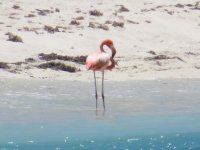 AAA American Flamingo Garden Key 040518 (1).jpg323.3 KB · Views: 32
AAA American Flamingo Garden Key 040518 (1).jpg323.3 KB · Views: 32 -
 AAA American Redstart Garden Key 040518 (1).jpg756.1 KB · Views: 33
AAA American Redstart Garden Key 040518 (1).jpg756.1 KB · Views: 33 -
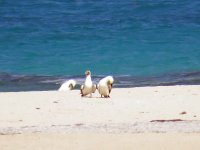 AAA Masked Booby Hospital Key 040518 (2).jpg410.4 KB · Views: 42
AAA Masked Booby Hospital Key 040518 (2).jpg410.4 KB · Views: 42 -
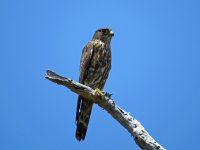 AAA Merlin Garden Key 040518 (1).jpg279.8 KB · Views: 42
AAA Merlin Garden Key 040518 (1).jpg279.8 KB · Views: 42 -
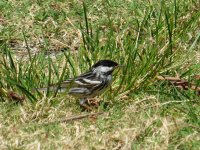 AAA Blackpoll Warbler Garden Key 040518 (1).jpg885.7 KB · Views: 34
AAA Blackpoll Warbler Garden Key 040518 (1).jpg885.7 KB · Views: 34





